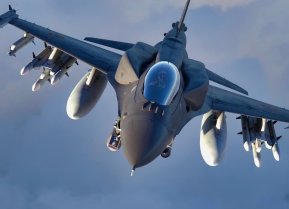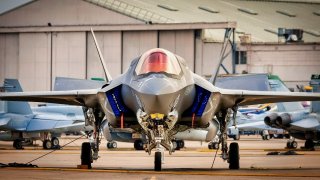F-35: Is There Any Chance This Stealth Fighter Gets Canceled?
To date, F-35 cancellation does not have serious traction. But it wouldn’t be unheard of for a cutting-edge fifth-generation fighter to be canceled sooner than expected. The F-22 Raptor recently suffered such a fate after less than 200 airframes had been produced.
At $1.75 trillion, the F-35 Joint Strike Fighter is the most expensive weapons program ever. And when a single weapons program costs nearly twice as much as the US’s annual defense budget, questions are going to be raised – questions like: should the F-35 be canceled? Will the F-35 be canceled?
To date, F-35 cancellation does not have serious traction. But it wouldn’t be unheard of for a cutting-edge fifth-generation fighter to be canceled sooner than expected. The F-22 Raptor recently suffered such a fate after less than 200 airframes had been produced.
Canceling the F-35?
Some critics have proposed that the F-35 be canceled. Danaka Katovich, writing in Jacobin argued that ‘The Government Should Cancel the F-35 Program and Replace It With Nothing.’
“Two facts about the F-35 fighter plane are nearly universally recognized: first, the plane has capabilities never before seen in a fighter jet, and second, it’s a complete disaster,” Katovich wrote. “At a record-breaking cost of $1.75 trillion in public money, with hardly anything to show for it, the F-35 project is increasingly hard to rationalize. Even top government officials are now criticizing it, posing the question: Could the project be nearing its termination?”
Katovich may be engaged in wishful thinking. Or maybe Katovich is ahead of the curve; the F-22 program was canceled sooner than expected.
However, the comparison may not be appropriate. Let’s consider the F-22’s cancellation.
Canceling the F-22
The F-22 was canceled after just 186 airframes had been delivered to the US Air Force. The production line was converted to build new F-35s, which will make building new F-22s extremely difficult.
The Air Force was comfortable letting the F-22 slide away, in part, because the jet’s design and avionics were becoming outdated, and updates would have been a costly partial fix. Besides, a replacement for the F-22 is already being developed – the Next Generation Air Dominance Program.
And, in part, the F-22 is being retired because the jet is so expensive to operate relative to older jets like the F-15 and F-16, which are still capable under certain conditions.
But the F-22 was always meant to be a bridge aircraft.
“The F-22 is, in many ways, a bridge between two very different air combat philosophies,” Sandboxx reported. “Its high degree of maneuverability, born in large part out of its thrust-vector control, combined with its high thrust-to-weight ratio and the Raptor’s M61A2 20mm Gatling gun make it an adept dogfighter on par with some of the most capable 4th generation air superiority platforms in the world. However, the Raptor also boasts the smallest radar cross-section of any 5th-generation fighter, alongside a high degree of sensor fusion and situational awareness, allowing its pilot to engage enemy fighters from beyond visual range, often before the opponent even knows that the F-22 is there.”
In sum, the F-22 can do a little bit of everything – fight up-close or fight from a distance – but the F-22 is the master of neither circumstance. “There are certainly more aerobatic fighters in the world, and the F-35’s sensor fusion and data management capabilities are a huge improvement over the F-22s.” And as surface-to-air technology improves, the thirty-year-old F-22 may not be equipped to survive in contested air space.
So, the F-22 was a viable candidate for cancellation. The F-35 – still the world’s most capable sensor-fusing and data-managing fighter jet – is less so. But the F-35’s myriad problems –namely delays and cost overruns – have generated legitimate criticism.
According to Katovich, the F-35 “is behind schedule and costs more than we originally thought. Does the plane at leas work like it’s supposed to? No. No, it doesn’t.”
“The F-35 is still not ready for full-scale production,” Katovich wrote. “A myriad of technical issues with the engine have been reported…An analyst at the Government Accountability Office (GAO) attributed the F-35’s failures to its complexity, saying, “They tried to make the F-35 do too much.”
Katovich and the press are not the only ones critiquing the F-35; members of Congress have also had harsh words for the fifth-generation fighter. Representative Adam Smith, chair of the House Armed Services Committee, called the F-35 a “rathole.” Meanwhile, Representative John Garamendi asked of the F-35 program: “For the contractors out there, what are you doing? Why can’t you give us a piece of equipment that actually works?”
And, crucially, the Biden administration asked for a 35-percent reduction to F-35 procurements in 2023. But the F-35 is not yet being seriously discussed for cancellation. The Senate Armed Services Committee recently added seven F-35s to the budget, demonstrating the F-35 will be around for the foreseeable future.
About the Author
Harrison Kass is a defense and national security writer with over 1,000 total pieces on issues involving global affairs. An attorney, pilot, guitarist, and minor pro hockey player, Harrison joined the US Air Force as a Pilot Trainee but was medically discharged. Harrison holds a BA from Lake Forest College, a JD from the University of Oregon, and an MA from New York University. Harrison listens to Dokken.


